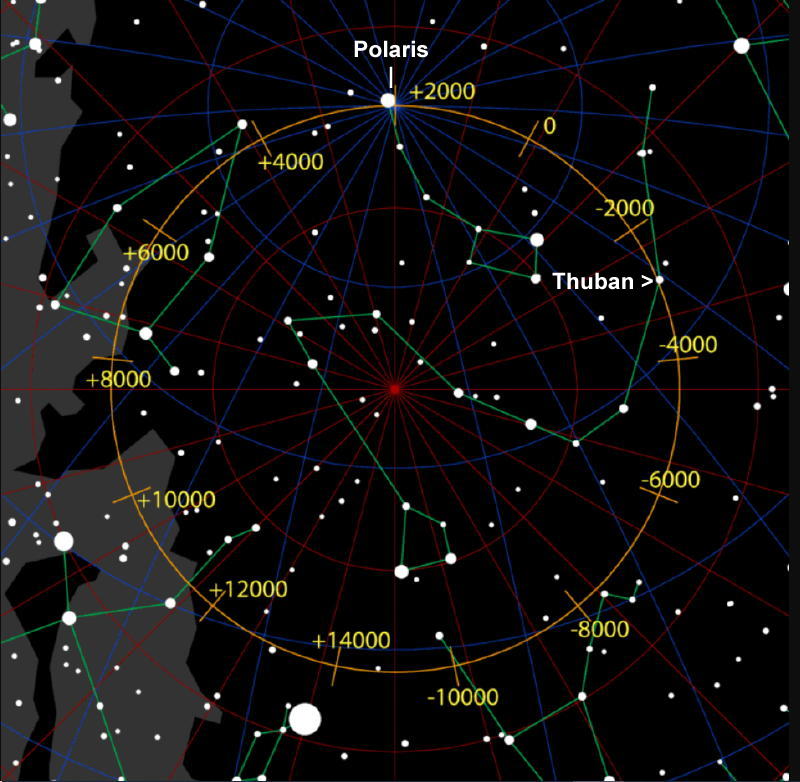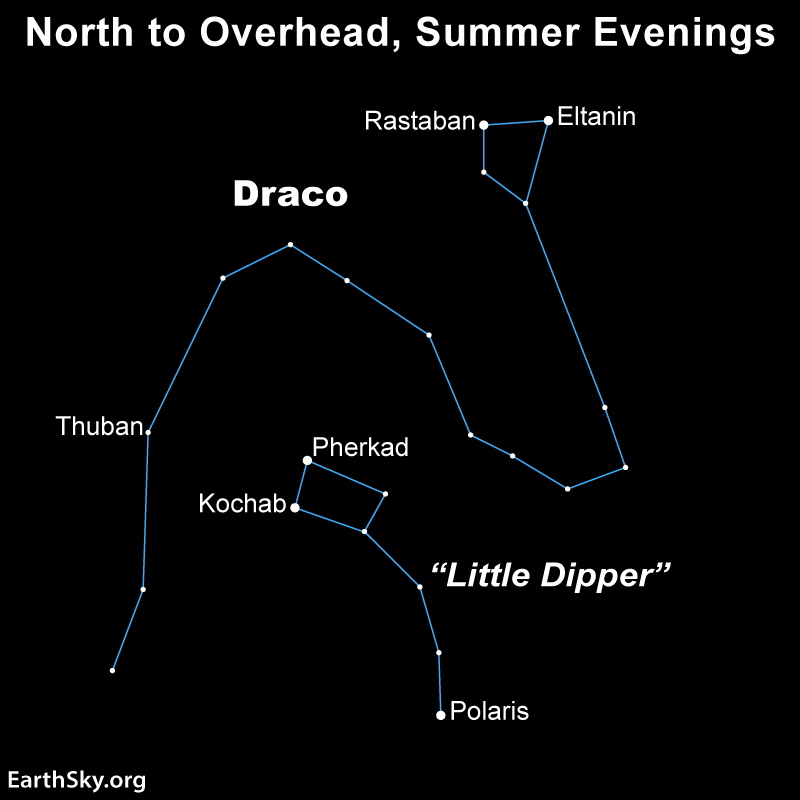
Draco and its famous star Thuban
Tonight, if you have a dark sky, you’ll be able to pick out the constellation Draco the Dragon winding around our modern-day pole star, aka the North Star, which we call Polaris. The image at the top of this post shows Draco as depicted in an old star atlas by Johannes Hevelius in 1690. See the circle? It indicates the changing position of the north celestial pole over a cycle of 26,000 years.
The 26,000-year cycle is known as precession. It’s a slow, smooth wobbling that causes a change in the orientation of Earth’s axis over time. Precession causes Earth’s axis to trace out a circle among the stars. Thus, over time, Earth’s axis points to various stars, and the identity of our North Star changes.
Precession of the Earth's Rotation Axis and North Star. The Earth's rotation axis is not fixed in space. Like a rotating toy top, the direction of the rotation axis executes a slow precession with a period of 26,000 years. https://t.co/h7nS1BCuOl pic.twitter.com/SRVQGQDYP0
— Space Explorer Mike ?? (@MichaelGalanin) March 27, 2021
So our modern-day Polaris wasn’t always our north pole star. It was once an ordinary star in the northern sky, called Phoenice. And a star in Draco, called Thuban, was the pole star when the Egyptians built the pyramids some 5,000 years ago.

Draco winds between the Big and Little Dippers
Luckily, the Big Dipper can help guide you to Draco and its star Thuban. Just remember … the entire Dragon requires a dark sky to see. You’ll find the Big Dipper high in the north on June evenings. The two outer stars in the Dipper’s bowl point to our modern-day Polaris, the North Star, which marks the end of the Little Dipper’s handle.
The Little Dipper is relatively faint. If you can find both Dippers, then your sky is probably pretty dark. And you’ll need that dark sky to see Draco. You’ll have to let your eyes and imagination drift a bit to see the entire winding shape of the Dragon in the northern heavens.
See how the tail of Draco winds between the Big and Little Dippers on the chart below?

And here’s Draco the Dragon and the Little Dipper. The four stars that make up Draco’s head usually are the easiest pattern to pick out.

Thuban is easy to find
Also – if you can find both Dippers, and if your sky is relatively dark – you can easily pick out Thuban. The star is easy to find by looking between the Dippers. However, it is four times fainter than Polaris. Thuban is famous for having served as a pole star around 3000 BCE. This date coincides with the beginning of the building of the pyramids in Egypt. It’s said that the descending passage of the Great Pyramid of Khufu at Gizeh was built to point directly at Thuban. So, our ancestors knew and celebrated this star. Now, the descending path points toward Polaris, the current North Star.
Thuban reigned as the pole star for more than a thousand years. It was closest to the pole in the year 2830 BCE, at a distance of only 10 arcminutes, or 1/6 of a degree. This even “out-polar-ized” Polaris, which will get no closer than 27 arcminutes to true north next century.
Thuban as North Star
For 200 years, Thuban was within 1 degree of true north. But as the centuries passed, so did the stars targeted to be our North Star. Thuban will get its turn again in the year 20,346 CE. Don’t wait up for it!
Through a telescope, Thuban is a blue-white star, magnitude 3.67. It is located 303 light-years away, is about five times larger than our sun, and shines 240 times brighter than our sun. It has a companion, but it is too close to the primary star to observe.
And Polaris? Its reign began in 1547 when Gemma Frisius first referred to it as “that star which is called polar.” In July 2016, the International Astronomical Union‘s (IAU) Working Group on Star Names officially declared the star to be named Polaris.
Then, in a few thousand years, Polaris will no longer be the North Star. Perhaps then the IAU will assemble the Working Group of Star Names and change the name back to Phoenice. (P.S. Dear Pluto, there is hope!)
Read more about Thuban, a former pole star
Read more: How to find the Big Dipper
Bottom line: Let your eyes and imagination drift a bit to see the entire winding shape of Draco the Dragon in the northern sky. If you do spot it, be sure to pick out Thuban, a former pole star.











